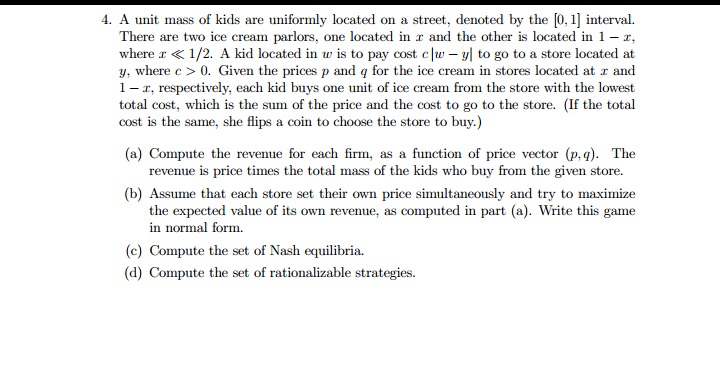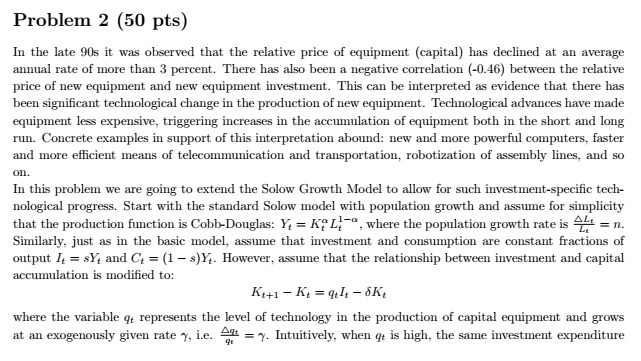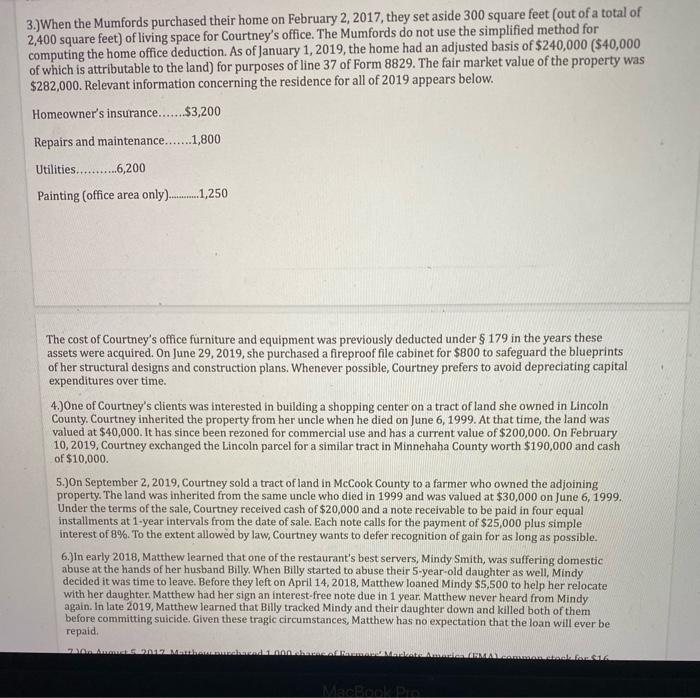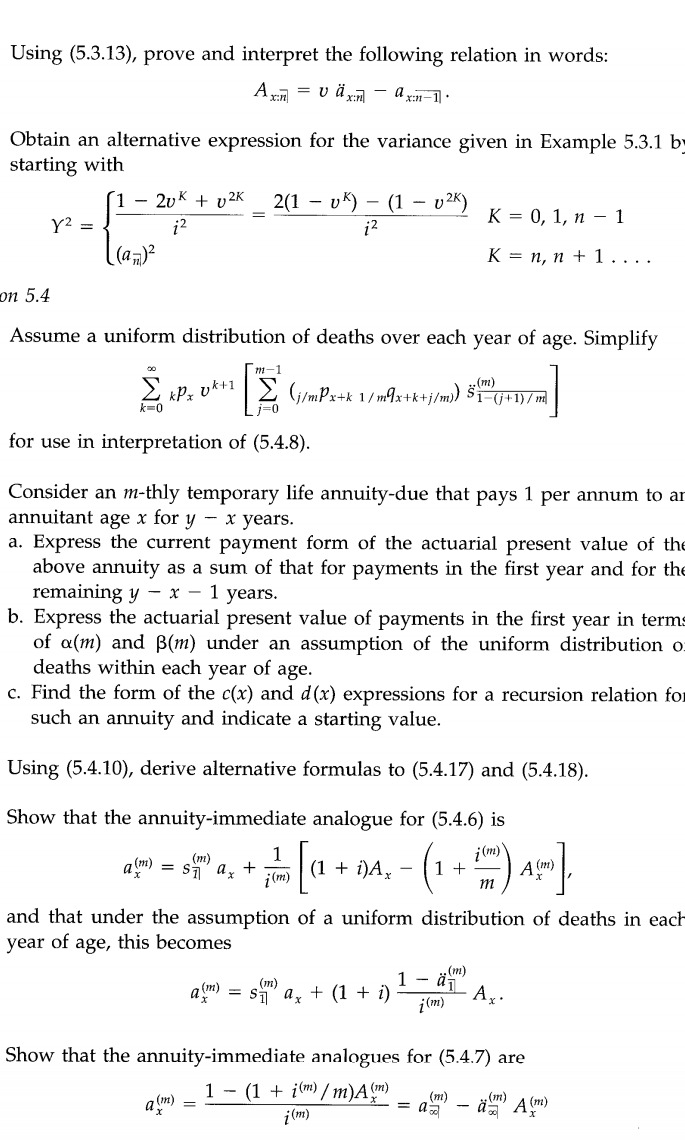



4. A unit mass of kids are uniformly located on a street, denoted by the [0, 1] interval. There are two ice cream parlors, one located in r and the other is located in 1 - r, where r 0. Given the prices p and q for the ice cream in stores located at r and 1 -r, respectively, each kid buys one unit of ice cream from the store with the lowest total cost, which is the sum of the price and the cost to go to the store. (If the total cost is the same, she flips a coin to choose the store to buy.) (a) Compute the revenue for each firm, as a function of price vector (p. q). The revenue is price times the total mass of the kids who buy from the given store. (b) Assume that each store set their own price simultaneously and try to maximize the expected value of its own revenue, as computed in part (a). Write this game in normal form. (c) Compute the set of Nash equilibria. (d) Compute the set of rationalizable strategies.Problem 2 (50 pts) In the late 90s it was observed that the relative price of equipment (capital) has declined at an average annual rate of more than 3 percent. There has also been a negative correlation (-0.46) between the relative price of new equipment and new equipment investment. This can be interpreted as evidence that there has been significant technological change in the production of new equipment. Technological advances have made equipment less expensive, triggering increases in the accumulation of equipment both in the short and long run. Concrete examples in support of this interpretation abound: new and more powerful computers, faster and more efficient means of telecommunication and transportation, robotization of assembly lines, and so on. In this problem we are going to extend the Solow Growth Model to allow for such investment-specific tech- nological progress. Start with the standard Solow model with population growth and assume for simplicity that the production function is Cobb-Douglas: Y = K" L, ", where the population growth rate is = n. Similarly, just as in the basic model, assume that investment and consumption are constant fractions of output It = sY, and Ct = (1 - s)Y. However, assume that the relationship between investment and capital accumulation is modified to: Kit1 - Ke = qthe - 6Kt where the variable q, represents the level of technology in the production of capital equipment and grows at an exogenously given rate y, i.e. 24 = y. Intuitively, when of is high, the same investment expenditure3.)When the Mumfords purchased their home on February 2, 2017, they set aside 300 square feet (out of a total of 2,400 square feet) of living space for Courtney's office. The Mumfords do not use the simplified method for computing the home office deduction. As of January 1, 2019, the home had an adjusted basis of $240,000 ($40,000 of which is attributable to the land) for purposes of line 37 of Form 8829. The fair market value of the property was $282,000. Relevant information concerning the residence for all of 2019 appears below. Homeowner's insurance.......$3,200 Repairs and maintenance.......1,800 Utilities...........6,200 Painting (office area only)...1,250 The cost of Courtney's office furniture and equipment was previously deducted under $ 179 in the years these assets were acquired. On June 29, 2019, she purchased a fireproof file cabinet for $800 to safeguard the blueprints of her structural designs and construction plans. Whenever possible, Courtney prefers to avoid depreciating capital expenditures over time. 4.)One of Courtney's clients was interested in building a shopping center on a tract of land she owned in Lincoln County. Courtney inherited the property from her uncle when he died on June 6, 1999. At that time, the land was valued at $40,000. It has since been rezoned for commercial use and has a current value of $200,000. On February 10, 2019, Courtney exchanged the Lincoln parcel for a similar tract in Minnehaha County worth $190,000 and cash of $10,000. 5.)On September 2, 2019, Courtney sold a tract of land in McCook County to a farmer who owned the adjoining property. The land was inherited from the same uncle who died in 1999 and was valued at $30,000 on June 6, 1999. Under the terms of the sale, Courtney received cash of $20,000 and a note receivable to be paid in four equal installments at 1-year intervals from the date of sale. Each note calls for the payment of $25,000 plus simple interest of 8%. To the extent allowed by law, Courtney wants to defer recognition of gain for as long as possible. 6.)In early 2018, Matthew learned that one of the restaurant's best servers, Mindy Smith, was suffering domestic abuse at the hands of her husband Billy. When Billy started to abuse their 5-year-old daughter as well, Mindy decided it was time to leave. Before they left on April 14, 2018, Matthew loaned Mindy $5,500 to help her relocate with her daughter. Matthew had her sign an interest-free note due in 1 year. Matthew never heard from Mindy again. In late 2019, Matthew learned that Billy tracked Mindy and their daughter down and killed both of them before committing suicide. Given these tragic circumstances, Matthew has no expectation that the loan will ever be repaid.Using (5.3.13), prove and interpret the following relation in words: Arn = Udxn - axn-1 . Obtain an alternative expression for the variance given in Example 5.3.1 b starting with 1 - 20 + 2K _ 2(1 - Uk) - (1 - U2K) Y2 = 12 K = 0, 1, n - 1 ((a 7 7 )2 K= n, n +1 . . .. on 5.4 Assume a uniform distribution of deaths over each year of age. Simplify [ (jimPxt* 1 / mixtiti/ ml) $1- (+1)/md for use in interpretation of (5.4.8). Consider an m-thly temporary life annuity-due that pays 1 per annum to a annuitant age x for y - x years. a. Express the current payment form of the actuarial present value of the above annuity as a sum of that for payments in the first year and for the remaining y - x - 1 years. b. Express the actuarial present value of payments in the first year in term of a(m) and B(m) under an assumption of the uniform distribution o deaths within each year of age. c. Find the form of the c(x) and d(x) expressions for a recursion relation for such an annuity and indicate a starting value. Using (5.4.10), derive alternative formulas to (5.4.17) and (5.4.18). Show that the annuity-immediate analogue for (5.4.6) is a(m) = ] ax + i(m) (1 + DA, - (1+ 1 ) A ( ] . and that under the assumption of a uniform distribution of deaths in each year of age, this becomes am) = s7 a, + (1 + i) 1 - a1 i (m) -Ax. Show that the annuity-immediate analogues for (5.4.7) are a(m) = 1 - (1 + i(") / m)Agn) (m) _ i (m) as A (m)














